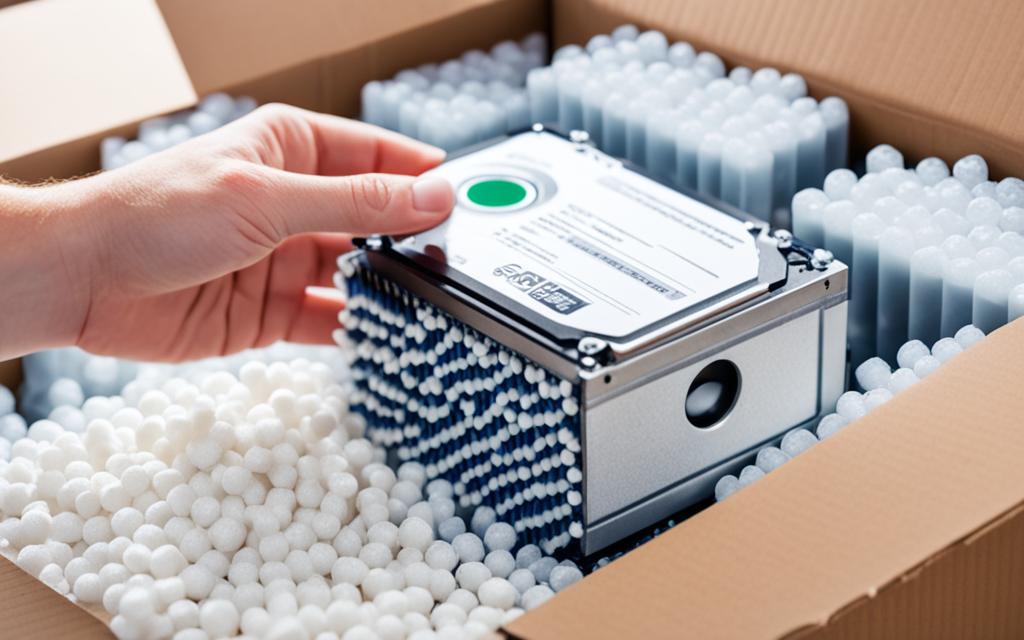Table of Contents
If you need to transport your desktop computer in a car, follow these steps to keep it safe. Start by wrapping your computer with bedding linen or clothes. This will help protect it from bumps on the road. Then, take off the side panel and, if you can, remove the graphics card and memory modules. This is to insulate the system against shocks and vibrations.
If removing parts sounds too tricky, you have another option. You can use plastic bags filled with packing peanuts. Put these inside the computer to keep everything snug. Just be careful not to push too hard around the parts.
When it’s time to move, make sure the motherboard is lying flat and faces up. For tower systems, this means laying the computer on its right side. It’s very important to drive smoothly. Avoid bumps to keep your computer from getting damaged1.
Key Takeaways:
- Wrap the computer with bedding linen or clothing to minimize shock and vibration during transport.
- Remove the side panel and any detachable components for added safety.
- If not disassembling, place loosely filled plastic bags inside the computer to cushion the components.
- Keep the motherboard flat and facing up during transport.
- Ensure all wheels are on the ground to avoid damage to the computer.
Packing Materials for Transporting a Computer
Choosing the right packing materials for your computer is very important. It makes sure your computer stays safe while moving or shipping. You’ll need some essential materials:
- Boxes: If the original box is gone, find a new sturdy, double-walled box. It should be big enough for your computer tower. Leave at least three inches of space for packing materials. You can also get special boxes for monitors and accessories. These provide extra protection. (Source:2)
- Packing Peanuts and Bubble Wrap: Anti-static peanuts or bubble wrap stop your computer from moving in the box. They also cushion it against knocks. (Source:2)
- Anti-Static Covers and Bags: Computers can be harmed by static electricity. Anti-static bags or covers protect against this. They ensure your computer’s safety on the trip. (Source:2)
- Tape, Markers, and Labels: Use strong tape to keep the boxes shut. Markers and fragile labels are also needed. They show the box has delicate items, ensuring careful handling. (Source:2)
Using these materials means your computer is safe during transport. Proper packaging leads to a smooth move or shipping. It brings peace of mind, knowing your computer is protected.
Disassembling the Computer for Transport
Before you move your computer, you must dismantle it carefully to keep it safe. This step keeps your computer protected during the move3.
Start by properly shutting down your desktop or all-in-one computer. Next, unhook all devices like the power cable, mouse, and keyboard4. Roll the cables neatly to save space and stay organised3.
Laptops and tablets are easier to prepare for moving. They don’t need as much work to disassemble3.
Packing each part separately adds extra safety during the move3. If you’re worried about damage, this is a good step. Taking photos before you dismantle everything helps with reassembly at your new place3.
It’s vital to back up your data to avoid losing it4. Ensure your files are safely stored on an external drive or in the cloud with services like Dropbox, OneDrive, GoogleDrive, or Amazon.[source]
Also, clearly label your computer parts boxes with your details and with “Fragile” and “Handle with Care” notices4. This helps ensure they’re handled carefully during the move, reducing the risk of harm3.
Packing and Securing the Computer Components
When you’re packing computer components for transport, it’s key to wrap and secure them well. Doing this keeps your valuable parts safe during the journey. Avoiding damage is possible with the right steps.
Wrapping and Cushioning for Protection
First, shield the components with an anti-static cover or computer bag. This step guards them against static and dust. Next, wrap items in bubble cushion or similar padding. This extra layer adds protection while moving.
Here’s the best way to wrap your computer parts:
| Computer Component | Wrapping Technique |
|---|---|
| Monitor and Tower | Keep them upright and wrap them in concentric circles with bubble cushion or padding material. |
| Scanner or Drawing Tablet | Lay them flat on the bubble cushion and wrap them like a gift, ensuring two to three layers of wrapping. |
Monitors and towers need a tight wrap to stop them from moving. This prevents damage. For flat items like scanners, resting them on bubble cushion adds safety.
Wrap every item two to three times. Secure the bubble cushion with tape so it stays in place.
Packing the Components in the Box
After wrapping, pack the components in a box. Here’s the safe way to do it:
- Begin with a few sheets of bubble cushion at the box’s bottom for shock absorption.
- Add packing peanuts for a cushion layer.
- Put the wrapped parts in the box. Ensure they fit tight and move little.
- Press down into the packing peanuts to secure the components.
- Fill any extra space with more peanuts. However, don’t overstuff and cause damage.
- Seal the box with tape.
- Properly label the box, highlighting the contents and any fragile items.
Packing well means your computer parts won’t get damaged in transit. Always better to be safe than sorry with these precautions.
Statistics from “Moving Your PC by Car: Practical Guide” for the Computer Electronics Industry:
- Many forum users suggest removing video cards for safer transport5.
- They recommend laying the PC flat to reduce stress on parts during the journey5.
- Packing the PC well prevents movement inside the car5.
- Anti-static bags are good for video cards5.
- Take out water cooling systems before moving5.
- Don’t leave the PC in the car overnight because of condensation5.
- Professional packing costs about $105.
- Car transport is safer for your PC than a moving truck1.
- Back up your computer before taking it apart for a move1.
- Wrap each hardware piece on its own, including the tower, monitor, and more1.
- Use air-filled plastic wrap for securing your computer parts1.
- Place the PC box behind the passenger seat in the car for a snug fit1.
- Pad the box with towels or linens to prevent it from shifting1.
- Keep a steady temperature and smooth ride during the move1.
- Unpack everything as soon as you get to your new place1.
- Insights from “Moving Your PC by Car: Practical Guide”:
- Packing Supplies:
| Materials | |
|---|---|
| Bubble wrap or packing paper | |
| Soft items (towels, blankets, etc.) | |
| Strong cardboard boxes (small and regular) | |
| Permanent marker | |
| Sealable gallon Ziplock bag/Zip-tie bags | |
| Packing tape | |
| Packing peanuts |
- How to Pack a Computer for Moving:
- Disassemble your PC.
- Unplug all cables.
- Keep cables secure.
- Wrap external hardware in bubble wrap.
- Gather items in a small box.
- About Labeling:
- Make sure labels show the contents are fragile and need careful handling.
- Placing a Desktop Computer in a Moving Truck:
- Clearly mark the box as “Fragile”.
- Avoid placing heavy items on the computer.
- Keep it away from extreme temperatures.
- Putting a Desktop PC in a Car:
- Last to load fragile items if you can.
- Ensure a secure spot behind the passenger seat.
- Keep the monitor upright or face up.
- On Safety:
- Drive carefully with fragile electronics.
- Proper packing is a must, even for short trips, to avoid breakage.
Conclusion
Moving a desktop computer in your car might seem scary. But, by taking the right steps, you can move your gear without harm. Follow this guide’s advice to keep your computer safe on the trip.
Start by securing the computer’s parts. Take out the hard drives and any big cards. Make sure the CPU cooler is tight. Check for anything loose and unplug what’s attached. This helps avoid damage.
Packing well is key to safe transport. Use anti-static bags and padding for the PC case. This lowers the chance of damage. For the monitor, following the 7 steps in this resource is a good idea.
Think about using professional movers or trusted carriers. They use straps to keep everything in place. Computers are fragile and fixing them can be costly. The right care and this guide’s tips will make moving your desktop easy and safe.
Source: Computer Info Bits6
FAQ
How can I transport my desktop computer in a car safely?
To keep your desktop computer safe in a car, wrap it in soft items like bedding or clothes. This helps against shocks. If you can, take off the side panel and take out the graphics card and RAM. Or, use plastic bags filled with packing peanuts inside for cushioning. Make sure the motherboard is flat and up. Also, keep the car steady to avoid any damage.
What packing materials do I need to transport a computer?
You’ll need a solid box that’s big enough for your computer plus packing material around it. Double-walled boxes are best for more safety. Use anti-static bubble wrap or peanuts for cushioning. Keep everything safe from static with anti-static covers. Don’t forget to use tape, box markers, and labels that say fragile.
How should I disassemble my computer for transport?
First, turn off your computer and unplug everything. For desktops, remove the power cord, mouse, keyboard, and stands. Laptops and tablets don’t need taking apart. Coil up cords to save space. Taking pictures before you start can help when you’re setting things up again.
How do I pack and secure the computer components?
Cover each part with anti-static material to protect from static and dust. Then, wrap them in bubble wrap for safety. Keep big parts like monitors and towers upright. Wrap them well. Flat items like scanners should be placed on bubble wrap and wrapped up. Put them in a box with bubble wrap at the bottom. Add packing peanuts to fill gaps and absorb shocks. But, don’t pack too tightly to avoid damage.
How can I safely transport my desktop computer in a car?
To transport your desktop safely, insulate it from bumps and take out parts if needed. Use the right packing stuff and make sure everything is secure. If you’re sending it, choose a good carrier and insure your computer for extra safety.
Source Links
- https://www.moving.com/tips/how-to-transport-a-pc-in-a-car/ – How to Transport a PC in a Car – Moving.com
- https://sekamoving.com/blog/how-to-pack-computers-for-moving-complete-guide-for-pc-moving/ – How to Pack a Computer for Moving? Tips on Сomputer Packing – SEKA Moving & Storage
- https://www.movers.com/packing-guides/how-to-move-a-computer-safely.html – Movers – Moving Companies, Moving Services, Free Quotes
- https://olympiamoving.com/2023/06/06/how-to-pack-a-pc-for-moving-a-step-by-step-guide/ – How to Pack a PC for Moving: A Step-by-Step Guide | Olympia Moving & Storage
- https://www.mmo-champion.com/threads/1511508-Transporting-a-computer – Thread: Transporting a computer
- https://www.mymovingreviews.com/move/how-to-pack-a-computer-when-moving/ – How to Pack a Computer for Moving: Step-by-Step Guide – MyMovingReviews








